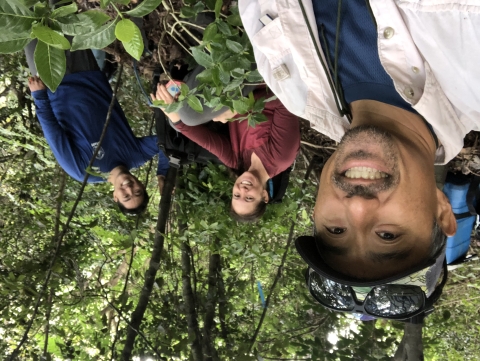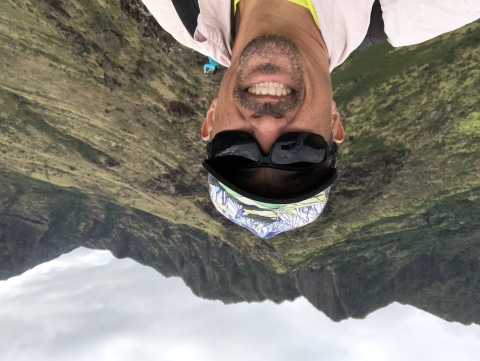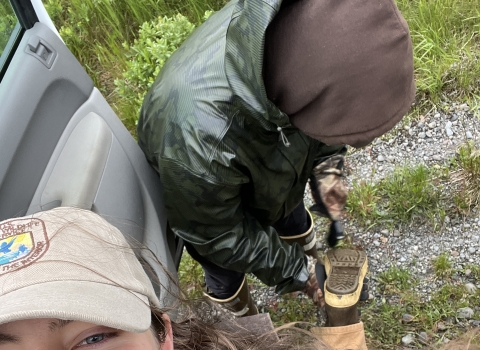Hawaiʻi is home to 44% of the nation's plant species listed under the Endangered Species Act of 1973. Today there are approximately 1,400 native Hawaiian plants remaining in the wild and almost 90% of those are found no where else in the world. Some of these plant species have less than 50 individuals remaining. While Hawaiʻi’s plants are often overshadowed by Hawaiʻi’s more charismatic species, there are cultivating professionals at the U.S. Fish and Wildlife Service who are commited to preserving Hawaiʻi’s plants and making sure they stay intertwined into Hawaiʻi’s ecosystem for years to come.
James Kwon is a biologist for the Pacific Islands Fish and Wildlife Office in Honolulu. As a descendant of Korean and Japanese immigrants to Hawaiʻi, James was raised to value not only his own cultural background, but the traditions and knowledge of the Native Hawaiian people as well. Raised in Mānoa Valley on the island of Oʻahu, James grew up the youngest of three to a father who was a pastor and a mother who was a schoolteacher. Because his mother taught science, James always had a fascination with science; though, it wasn’t until college when James would pursue science as a career.
James graduated with a Bachelor of Science degree in biology and economics at Claremont McKenna College in Claremont, California. It was also there that James admits his interest in plants took root.
“There was this one professor named Sherwin Carlquist,” said Kwon. “He wrote this book called ‘Island Biology,’ where he went to all these islands throughout the world and spent a lot of time in Hawaiʻi. I was amazed by the examples of endemism and plant radiations/evolution on islands and island systems around the world. He kind of started my interest in plants."
According to many, Hawaiʻi is often referred to many as the “Endangered Species Capital of the World,” so for James moving back home seemed like the natural next step. Starting with a paid internship with the Nature Conservancy of Hawaiʻi, James enrolled at the University of Hawaiʻi at Mānoa and sought a Master of Science degree in botany and conservation biology. During that time he also took on various part-time jobs doing research and natural resource management with U.S. military while also continuing his master’s research.
“I studied the genetic variation of two rare Hawaiian hardwood trees in the Rhamnaceae (Colubrina oppositifolia and Alphitonia ponderosa), both given the Native Hawaiian name, kauila,” said Kwon. “The trees were treasured by Native Hawaiians for their dense, richly-colored wood that was crafted into weapons, musical implements, and kapa (barkcloth) beaters.”
While James began as a botanist with the Service in 1999, his 23-year career has seen him wear many different hats and carries out a variety of roles.
“I’ve served as the lead biologist for safe harbor agreements, habitat conservation plans, listing and critical habitat rules, Section 7 Section 7
Section 7 Consultation
The Endangered Species Act (ESA) directs all Federal agencies to work to conserve endangered and threatened species and to use their authorities to further the purposes of the Act. Section 7 of the Act, called "Interagency Cooperation," is the mechanism by which Federal agencies ensure the actions they take, including those they fund or authorize, do not jeopardize the existence of any listed species.
Learn more about Section 7 consultations, and provided botanical expertise on refuge biological expeditions and surveys,” said Kwon. “As a Fish and Wildlife biologist and in my current role as the Department of Defense coordinator, I serve as the field office point of contact for all military branches in the main Hawaiian Islands. I provide technical assistance on Endangered Species Act compliance, Service policies and programs, species recovery, and field office strategic conservation goals. Other duties past and present include participation on our office’s Workplace Quality Team, Inclusion Diversity Equity and Accessibility (IDEA) Team, recruitment workshops, and Future of Work group.”
As a DOD coordinator, James promotes conservation for more than 100 threatened and endangered plants that occur on lands managed by the military in Hawai’i and the Mariana Islands. A vast majority of threatened and endangered plants reside within U.S. Army managed lands, so James and his department have worked closely with them to strategize and create a mutual conservation program that supports the militaries training needs while abiding by the ESA and Sikes Act of 1960.
In April 2022, James was honored as the Center for Plant Conservation: Conservation Champion for his dedicated work towards plant conservation within the Hawaiian and Mariana Islands. This achievement recognized James’ diligent efforts in his field and illuminating the traditional and deep connections people have with plants, demonstrating the cultural value of these species. The CPC is a non-profit organization committed to preventing the extinction of U.S. native plants and annually recognizes the work that individual plant conservationist perform.
“I think it’s nice to be recognized, but there are so many people doing so much other great work out there,” said Kwon. “I’m just happy to bring attention to the work that needs to be done for Hawaiian plant conservation. I think the main reason I was recognized was for the short presentations I did for the Hawaii Plant Genetics Workshops pairing ‘ōlelo noeau (Native Hawaiian proverbs, traditional sayings) with workshop topics such as phylogenic relationships, ex situ conservation, and novel approaches to rare plant conservation. It recognizes the presence and value of indigenous knowledge and the inter-relatedness of that knowledge with the work we do.”
For James, passing on knowledge and informing the next generation of conservationist has become important. Recently in James’ career he was selected for the Stepping Up to Leadership (SUTL) program, a program held at the National Conservation Training Center in Shepherdstown, West Virginia. A nationally competitive program, SUTL is dedicated to helping Service members improve their leadership abilities through skill assessments, coaching and personal development. James joins a select group of professionals that completed SUTL’s arduous, merit-based application process. This program provides James with the opportunity to share his professional perspectives and experiences based in the Pacific region, as well as learning from colleauges from other parts of the country. His participation supports not only his professional development, though exposes and expands the awareness of other colleagues being prepared to assume Service leadership roles in the future.
“Previously, I had never thought much about supervising or managing,” said Kwon. “Being selected to do a short supervisory detail as a team manager in 2021, exposed me to the management side of things and made me think about what I could do to contribute to the office using my knowledge and experiences to further the FWS mission and conservation in Hawaii and the Pacific Islands.
“So far, SUTL has been great,” continued Kwon. “I feel that it is the best training the Service has to provide. The instructors have been great, fellow members are all amazing, and I’ve been able to experience much personal growth and learning. It has given me greater self-awareness and emotional intelligence as I continue my leadership journey.”
The journey that James took towards joining the Service, as well as his path since, was not one that was traveled by design. James was able to carve out his own journey, through accepting new challenges when they were offered to him while also staying focused on preserving Hawaiʻi’s past through its plants. Supported by his parents, coworkers, and managers, James would tell anyone looking to begin a career in conservation, including his younger self to always be confident in your abilities.
###
The U.S. Fish and Wildlife Service works with others to conserve, protect, and enhance fish, wildlife, plants, and their habitats for the continuing benefit of the American people. For more information, visit www.fws.gov/pacificislands, or connect with us through any of these social media channels at https://www.facebook.com/PacificIslandsFWS, www.flickr.com/photos/usfwspacific/, https://medium.com/usfwspacificislands or www.twitter.com/USFWSPacific.






